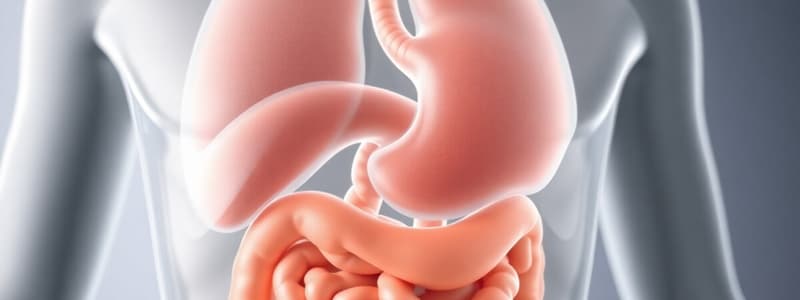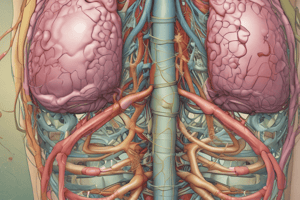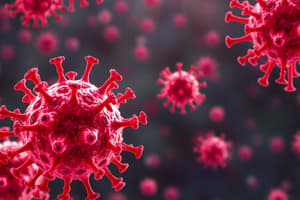Podcast
Questions and Answers
What is the primary function of the lymphatic system?
What is the primary function of the lymphatic system?
- To capture fluid and fight infections (correct)
- To produce hormones and regulate hormonal balance
- To digest food and absorb nutrients
- To regulate temperature and maintain homeostasis
Which organ injects bile during the digestive process?
Which organ injects bile during the digestive process?
- Pancreas
- Spleen
- Gallbladder
- Liver (correct)
What is the function of the dermis layer of the skin?
What is the function of the dermis layer of the skin?
- To serve as a barrier against pathogens
- To eliminate waste products through excretion
- To house nerve endings and support structures (correct)
- To provide insulation and energy storage
Which organ in the endocrine system is responsible for releasing insulin?
Which organ in the endocrine system is responsible for releasing insulin?
What specific role does epinephrine play in the body?
What specific role does epinephrine play in the body?
Which abdominal quadrant contains the liver and gallbladder?
Which abdominal quadrant contains the liver and gallbladder?
What is the primary organ of the renal system?
What is the primary organ of the renal system?
How does the integumentary system help maintain homeostasis?
How does the integumentary system help maintain homeostasis?
What is the role of the large intestine in the digestive system?
What is the role of the large intestine in the digestive system?
Which hormone is secreted by the adrenal glands during stress?
Which hormone is secreted by the adrenal glands during stress?
What is the primary function of the kidneys in the human body?
What is the primary function of the kidneys in the human body?
Which structure is responsible for transporting urine from the kidneys to the bladder?
Which structure is responsible for transporting urine from the kidneys to the bladder?
What role do the testes play in the male reproductive system?
What role do the testes play in the male reproductive system?
Which organ serves as the muscular structure that houses the fetus during pregnancy?
Which organ serves as the muscular structure that houses the fetus during pregnancy?
What occurs when an egg released from the ovaries meets sperm?
What occurs when an egg released from the ovaries meets sperm?
What pathway does the fetus follow during birth?
What pathway does the fetus follow during birth?
What does the term 'urethra' refer to?
What does the term 'urethra' refer to?
Which of the following structures is NOT part of the female reproductive system?
Which of the following structures is NOT part of the female reproductive system?
In what context is the complexity of the human body acknowledged?
In what context is the complexity of the human body acknowledged?
What is the purpose of the Fallopian tubes in the female reproductive system?
What is the purpose of the Fallopian tubes in the female reproductive system?
The primary function of the lymphatic system is to fight infections and capture fluid.
The primary function of the lymphatic system is to fight infections and capture fluid.
The stomach is located in the left lower quadrant of the abdomen.
The stomach is located in the left lower quadrant of the abdomen.
The epidermis is the deepest layer of the skin.
The epidermis is the deepest layer of the skin.
Insulin is released by the pancrea, which aids in the digestion of food.
Insulin is released by the pancrea, which aids in the digestion of food.
Epinephrine and norepinephrine are hormones released by the pituitary gland.
Epinephrine and norepinephrine are hormones released by the pituitary gland.
The kidneys are located in the retroperitoneal space behind the peritoneum.
The kidneys are located in the retroperitoneal space behind the peritoneum.
The colon is part of the digestive system that processes waste products.
The colon is part of the digestive system that processes waste products.
The gallbladder is primarily responsible for producing bile.
The gallbladder is primarily responsible for producing bile.
The integumentary system includes the skin and its associated structures.
The integumentary system includes the skin and its associated structures.
The fight or flight response is regulated by hormones such as oxytocin.
The fight or flight response is regulated by hormones such as oxytocin.
The kidneys are responsible for processing blood and removing toxins.
The kidneys are responsible for processing blood and removing toxins.
The bladder stores bile until it is needed for digestion.
The bladder stores bile until it is needed for digestion.
The male reproductive system is composed of the testes and the vagina.
The male reproductive system is composed of the testes and the vagina.
The ureters transport urine from the kidneys to the bladder.
The ureters transport urine from the kidneys to the bladder.
Ovaries release eggs that travel through the urethra to the uterus.
Ovaries release eggs that travel through the urethra to the uterus.
The fetus grows in the uterus during pregnancy.
The fetus grows in the uterus during pregnancy.
The urethra is responsible for excreting urine from the bladder.
The urethra is responsible for excreting urine from the bladder.
Fallopian tubes connect the uterus to the ovaries.
Fallopian tubes connect the uterus to the ovaries.
The primary function of the testes is to produce sperm.
The primary function of the testes is to produce sperm.
Urination occurs through the penis in the male reproductive system.
Urination occurs through the penis in the male reproductive system.
Flashcards
What is the role of the lymphatic system?
What is the role of the lymphatic system?
The lymphatic system is a vital network that works alongside the circulatory system, primarily focused on maintaining fluid balance, removing toxins and waste, and fighting infections.
What is the main purpose of the digestive system?
What is the main purpose of the digestive system?
The digestive system's primary function is to process ingested food, break down nutrients, and absorb them into the body. It also eliminates waste products.
What are some accessory organs of the digestive system?
What are some accessory organs of the digestive system?
The liver, gallbladder, pancreas, spleen, and appendix are considered accessory organs of the digestive system, contributing to nutrient absorption and waste elimination.
Describe the pathway of the digestive system.
Describe the pathway of the digestive system.
Signup and view all the flashcards
How is the abdomen divided?
How is the abdomen divided?
Signup and view all the flashcards
What are the main functions of the integumentary system?
What are the main functions of the integumentary system?
Signup and view all the flashcards
What is the epidermis?
What is the epidermis?
Signup and view all the flashcards
What is the dermis?
What is the dermis?
Signup and view all the flashcards
What is the subcutaneous layer?
What is the subcutaneous layer?
Signup and view all the flashcards
What is the role of the endocrine system?
What is the role of the endocrine system?
Signup and view all the flashcards
Kidney function
Kidney function
Signup and view all the flashcards
Bladder function
Bladder function
Signup and view all the flashcards
Ureter function
Ureter function
Signup and view all the flashcards
Urethra function
Urethra function
Signup and view all the flashcards
Testis function
Testis function
Signup and view all the flashcards
Penis function
Penis function
Signup and view all the flashcards
Ovary function
Ovary function
Signup and view all the flashcards
Fallopian tube function
Fallopian tube function
Signup and view all the flashcards
Uterus function
Uterus function
Signup and view all the flashcards
Vagina function
Vagina function
Signup and view all the flashcards
What do kidneys do?
What do kidneys do?
Signup and view all the flashcards
What is the bladder's role?
What is the bladder's role?
Signup and view all the flashcards
What are ureters?
What are ureters?
Signup and view all the flashcards
What does the urethra do?
What does the urethra do?
Signup and view all the flashcards
What do testes produce?
What do testes produce?
Signup and view all the flashcards
What is the function of the penis?
What is the function of the penis?
Signup and view all the flashcards
What is the role of the ovaries?
What is the role of the ovaries?
Signup and view all the flashcards
What are fallopian tubes?
What are fallopian tubes?
Signup and view all the flashcards
What is the uterus?
What is the uterus?
Signup and view all the flashcards
What is the vagina?
What is the vagina?
Signup and view all the flashcards
Study Notes
Lymphatic System
- Main functions: Fluid capture, fluid balance, infection fighting (using lymph nodes to capture bacteria).
- Supports circulatory system by removing toxins and waste products via a parallel system.
- Lymphoid organs: Tonsils, spleen, thymus, lymph nodes.
Digestive System
- Function: Process food, extract nutrients, eliminate waste.
- Major organs: Stomach, small intestine, large intestine.
- Accessory organs: Liver, gallbladder, pancreas, spleen, appendix.
- Pathway: Mouth → esophagus → stomach → small intestine → large intestine (colon) → rectum → anus.
- Nutrient extraction begins in small intestine.
- Bile from liver aids in food breakdown.
- Large intestine processes waste culminating in excretion from anus.
- Abdominal quadrants:
- Right upper: Liver, gallbladder
- Left upper: Stomach, spleen, pancreas
- Right lower: Appendix, female reproductive structures
- Left lower: Large and small intestines (spanning all four quadrants).
Integumentary System (Skin)
- Functions: Protection (barrier from environment), water balance, temperature regulation, excretion, shock absorption, impact protection.
- Layers:
- Epidermis: Outermost (dead cells).
- Dermis: Functional layer (nerve endings and structures).
- Subcutaneous layer: Fatty layer (insulation, shock absorption, energy storage).
Endocrine System
- Function: Distribute hormones throughout the body.
- Organs release hormones into bloodstream, triggering responses in other body parts.
- Examples:
- Adrenal glands: Epinephrine and norepinephrine (fight-or-flight).
- Pancreas: Insulin (glucose regulation/digestion).
- Ovaries: Estrogen (female functions).
- Testes: Testosterone (male functions).
- Epinephrine and norepinephrine effects:
- Beta-1 receptors: Increase heart rate and force.
- Beta-2 receptors: Dilate bronchioles.
- Alpha-1 receptors: Constrict peripheral blood vessels.
Renal (Urinary) System
- Function: Regulate fluid levels, filter toxins, maintain pH balance.
- Primary organ: Kidneys (located in retroperitoneal space, adjacent to lower back).
- Pathway: Blood filtration by kidneys → waste products into bladder → excretion through urethra.
- Ureter: Tubes transporting urine from kidneys to bladder.
- Urethra: Tube excreting urine from bladder.
Reproductive Systems
- Male: Testes (produce sperm), penis (external reproductive organ, urination).
- Female: Ovaries (release eggs), fallopian tubes (connect ovaries to uterus), uterus (houses fetus), vagina (birth canal).
- Egg fertilization, embryo/fetus development in uterus, culminating in birth through vagina.
Studying That Suits You
Use AI to generate personalized quizzes and flashcards to suit your learning preferences.




